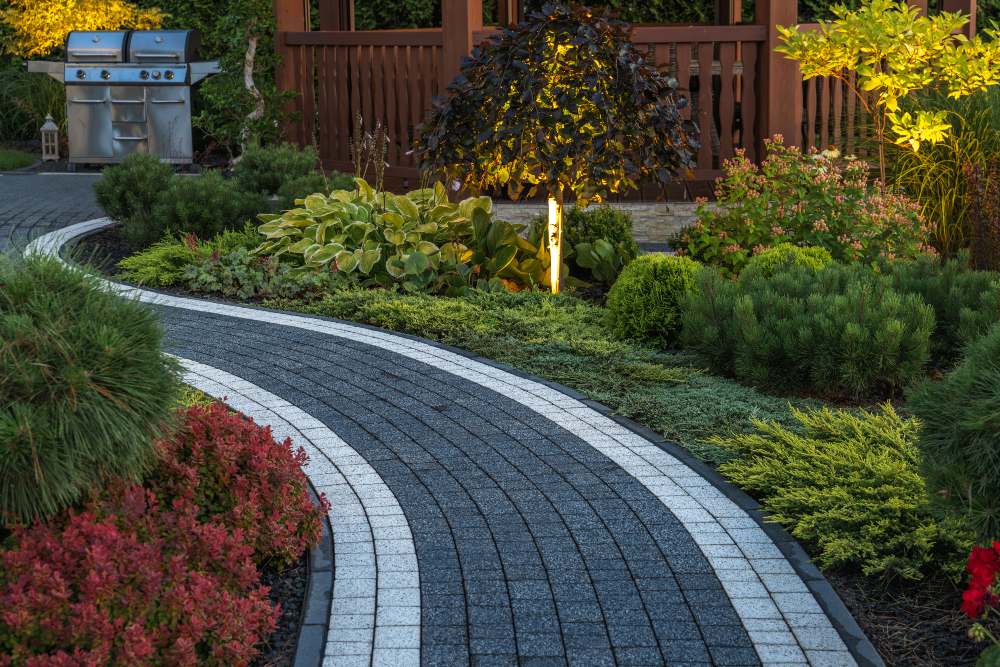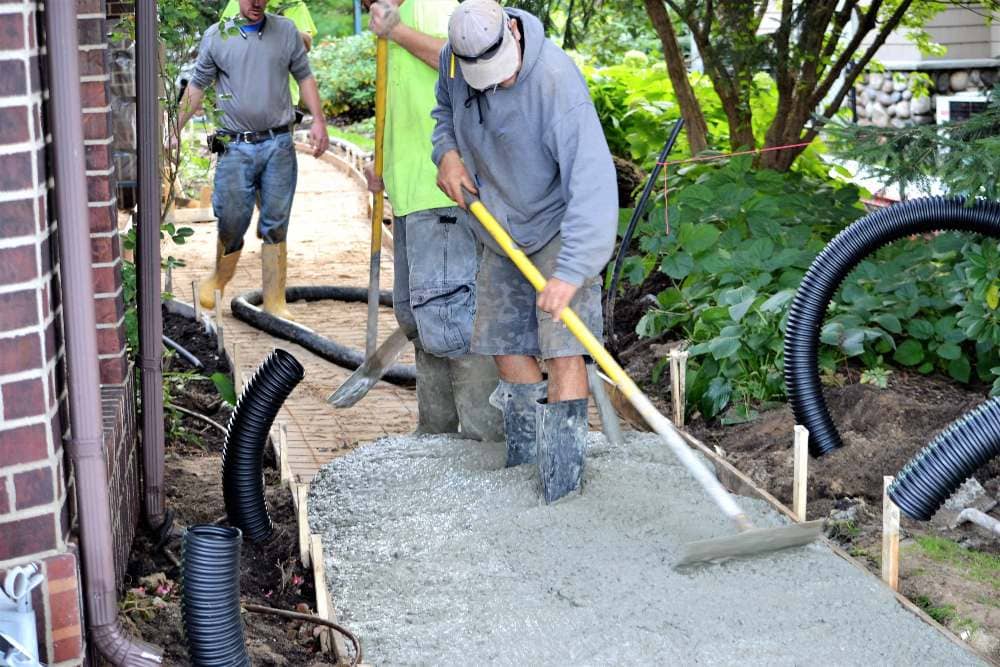Due to their durability and visual appeal, concrete pathways have become a popular choice for homeowners and landscape designers. These pathways offer aesthetic appeal and a practical solution for easy navigation around the home, seamlessly connecting alfresco areas, entrances, and pool spaces. As they can be crafted from various materials, including plain concrete, exposed aggregate, and stamped or stencilled designs, a style suits every aesthetic preference and budget.
One of the key benefits of concrete pathways is their long-lasting nature. Concrete can withstand harsh weather conditions, foot traffic, and even vehicle use when properly installed and maintained. This makes it an ideal option for both residential and commercial properties. In addition, concrete provides a firm and stable walking surface that minimises the risk of slips and falls, ensuring safety for users.
Moreover, the versatility of concrete allows for customisation and creativity in design. With various colours, textures, and patterns, homeowners can match their pathways to enhance the surrounding landscape and architecture further. The result is a cohesive look that enhances the overall appearance and value of the property while still providing a reliable and functional walking surface for years to come.
Key Takeaways
- Versatility and Durability: Concrete pathways offer a range of incredibly durable styles, making them ideal for residential and commercial use.
- Customisation Options: With various materials, colours, and textures available, concrete pathways can be tailored to enhance any property’s aesthetic.
- Practicality and Safety: Concrete provides a stable, slip-resistant surface, ensuring safety and functionality.
- Maintenance and Longevity: Regular care and proper installation techniques ensure the longevity of concrete pathways.
- Environmental Considerations: Thoughtful planning and construction can minimise environmental impacts, making concrete pathways a sustainable choice.
Disclaimer: This content is intended for informational purposes only and should not be considered professional advice. Please consult a licensed professional or contractor for specific needs or expert solutions.

Design and Planning for Concrete Pathways
Materials and Aesthetics
When designing concrete pathways and driveways, consider various materials contributing to structural integrity and aesthetics. The primary components of pathways are cement, aggregate, and water. Aggregates can include a mix of sand and gravel or exposed aggregate with a decorative, textured finish. Experiment with coloured concrete and design patterns to create a stylish and personalised appearance that complements your landscaping and entrance areas.
Initial Site Preparation
Before constructing your concrete pathway, prepare the site by excavating any grass, plants, or obstacles. Ensure a minimum depth of 100mm, allowing additional sub-base materials such as sand or compacted gravel. Using pegs or stakes to mark boundaries and establish the pathway height to maintain a level surface. Additionally, consider the stormwater flow and ensure proper drainage to prevent waterlogging.
Concrete Pathway Construction
Begin the job by setting up formwork using materials such as plywood or steel mesh along the marked boundaries. Use a wheelbarrow, shovel, and concrete mixer for an accurate and confident concrete mixer. When pouring the concrete, distribute it evenly using a shovel and ensure it reaches the edges of the formwork.
During construction, integrate expansion joints to account for any movement caused by temperature changes and control joints to prevent cracking. Employ a concrete groover to create these joints. After pouring the concrete, compact the mixture with a plate compactor to remove any air pockets, ensuring a solid surface.
Finishing Techniques
Once the concrete is poured, use various finishing techniques to achieve the desired appearance. For a smooth and polished look, float the surface with a trowel. Use a broom or brush to add texture to create a non-slip surface. When creating exposed aggregate pathways, wash away the top layer of cement to reveal the decorative aggregates beneath.
Curing is vital to ensuring the durability and longevity of your driveway or concrete pathway. After finishing the surface, cover it with plastic sheeting for at least seven days to retain moisture.
Safety Measures
Safety should be at the forefront of any DIY project, particularly when handling concrete. Wear protective gear, such as long pants, gumboots, gloves, and safety glasses, to minimise the risk of injury during the construction process. Additionally, follow manufacturer guidelines for all equipment, and seek professional assistance if necessary.
Transform your landscape with Superior Concrete’s custom concrete driveway solutions. Call us at 1300 826 505 for a quote.
Maintenance and Longevity
Concrete pathways are known for their durability and low maintenance requirements. However, ensuring their longevity involves dedicated attention to preventive measures and effective repair and upkeep practices. This section will discuss these essential aspects to promote a long-lasting, high-quality concrete pathway.
Preventive Measures
To avoid potential issues with concrete paving, strict attention must be given to the quality of materials and construction techniques. These measures contribute to a long-lasting and durable pathway:
- Proper Mixture: Ensure the concrete mixture includes appropriate amounts of cement, aggregate, and water. This helps avoid air pockets, which can lead to cracking.
- Expansion Joints: Incorporate expansion joints at regular intervals to allow for seasonal changes and prevent cracking caused by expansion and contraction.
- Curing: Allow enough time for the concrete to cure properly before it is exposed to heavy foot traffic or subjected to other external forces like high water levels.
- Sealing: Apply a high-quality sealant to protect the surface from water penetration, improving durability.
Repair and Upkeep
Despite the inherent low-maintenance nature of concrete pathways, regular checks and timely repairs can significantly improve their longevity. Here are some essential aspects to consider in repairing and maintaining concrete paving:
- Regular Inspection: Check for signs of cracking, chipping, or staining and address these issues promptly.
- Cleaning: Remove dirt and debris from the pathway regularly to maintain the appearance and prevent deterioration due to accumulated materials.
- Resealing: Apply a fresh sealant layer every few years to maintain the protective barrier, preventing water penetration and improving overall durability.
- Addressing Cracks: In case cracks appear, promptly clean, fill, and repair them using high-quality materials and appropriate techniques, thus mitigating further deterioration.
Adhering to these preventive measures and maintenance practices will significantly extend your concrete pathway’s lifespan. By focusing on quality construction from the start and diligently addressing any potential issues, you can ensure your concrete pathway remains durable and functional for years to come.

Practical Considerations
Cost and Budgeting
When planning a concrete pathway, it is essential to consider the cost and budget. Concrete is a versatile material that can be more cost-effective than pavers or stones, especially for larger areas. The cost of a concrete pathway can vary depending on the size and finishing. It is essential to calculate the concrete required by determining the cubic metres needed for the project since concrete is typically charged per cubic metre.
Premixed concrete is an option for smaller projects, as it can be easily transported in a wheelbarrow and can save time on mixing. However, the cost can be higher when mixing the concrete on-site. Here is a sample cost breakdown for a concrete pathway project:
- Materials: Concrete (premixed or bagged), reinforcement mesh, formwork
- Tools and Equipment: Wheelbarrow, shovel, trowel, screed, edging tool, float, builder’s square, string line
- Labour: DIY or professional installation (cost will vary)
Be sure to compare quotes from different suppliers and concrete contractors to ensure the best deal for your substantial pathway project.
Environmental Impact
As the world becomes more conscious of environmental sustainability, the impact of constructing a concrete pathway should also be considered. While concrete may not be as eco-friendly as grass or gravel, it can still be an environmentally sound choice when properly planned, constructed and maintained.
For instance, a properly designed concrete pathway can help manage stormwater runoff. This can reduce the chance of erosion and the infiltration of harmful chemicals into the water table. It is essential to ensure that the pathway is graded to slope away from buildings. If it cannot be graded, a surface drain should be connected to the stormwater system.
Another environmental consideration is the potential for unwanted pests like ants to establish nests in a pathway, as the material can provide a stable and long-lasting home for these creatures. To minimise the effects on the local ecosystem, choose a less invasive species of ants or maintain an appropriate barrier around the pathway.
While concrete pathways are attractive and practical additions to your house or yard, it’s crucial to consider the project’s cost, budgeting, and environmental impact. By doing so, you can make an informed decision on the best materials and planning to suit your needs, creating a functional and environmentally friendly pathway.
Looking for long-lasting and aesthetic walkways? Explore Superior Concrete’s expert concrete formwork services. Dial 1300 826 505 today!
Installation and DIY Tips
Step-by-Step Guidance
Building a concrete path can be a great DIY project, adding functionality and visual appeal to your home or garden. Follow these simple steps to install a concrete pathway:
- Site Preparation: Mark out the path with stakes and paint, then excavate to a depth of about 100mm. Ensure the ground slopes away from buildings and sits below the internal floor level. Remove grass, dirt, and debris, and compact the soil for a solid base.
- Formwork: To create the formwork, use 12mm plywood and 50 x 50 mm hardwood pegs spaced 500mm apart. Secure the formwork to the pegs using 40mm bullethead nails. If the formwork extends more than 150mm above the ground, brace the pegs with a kicker.
- Base Material: Pour gravel to a depth of 10cm and smooth it out, ensuring a flat surface. You can also place a steel mesh on top of the gravel to provide adequate support.
- Concrete Mix: Prepare your concrete mix according to the manufacturer’s instructions. Consider local weather conditions and expected loads and choose a mix suitable for outdoor pathways.
- Pouring Concrete: Pour the concrete into the formwork, distributing it evenly. For more extensive paths, consider dividing the project into smaller sections, making it easier to handle and ensuring better results.
- Levelling and Finishing: Use a screed to level the concrete surface, then a bull float to smoothen it. Take care to remove any air pockets, which can cause cracks in the path.
- Curing: Allow the concrete to cure correctly. Depending on weather conditions and the mix used, this process may take several days or weeks. Refrain from walking on the path during this time.
Troubleshooting Common Issues
- Cracking: To avoid cracking, ensure adequate ground preparation and include steel mesh in the base. Control joints can be placed at regular intervals to manage the occurrence of cracks. If cracking still occurs, filling with an appropriate sealant can help prolong the path’s lifespan.
- Air Pockets: Thoroughly tamping and vibrating the concrete mix will help eliminate air pockets, which can cause weaknesses in the path.
- Hot Days: Avoid installing a concrete path during sweltering days, as rapid drying can lead to cracks. If this cannot be avoided, use a slower-curing mix and moisten the freshly poured concrete by sprinkling water to facilitate proper curing.
- Temperatures: Different temperatures and weather conditions can affect the curing process of concrete. To ensure optimal results, plan your project accordingly and choose a suitable concrete mix that withstands local conditions.
By following these guidelines, you can confidently complete your concrete pathway DIY project while ensuring the durability and appeal of your new path.
Parting Thoughts
In conclusion, concrete pathways are not just functional elements; they are integral parts of a property’s overall design and appeal. From the choice of materials to the finishing touches, every aspect of a concrete pathway can be customised to reflect personal style while ensuring durability and safety. Whether you’re a homeowner or a commercial property manager, understanding these principles can guide you in making informed decisions for your landscaping needs.
Further Reading
Expand your knowledge and get inspired for your next project with these additional resources:
Enhance your property’s appeal with Superior Concrete’s professional concrete resurfacing. For detailed information, contact us or call 1300 826 505.

